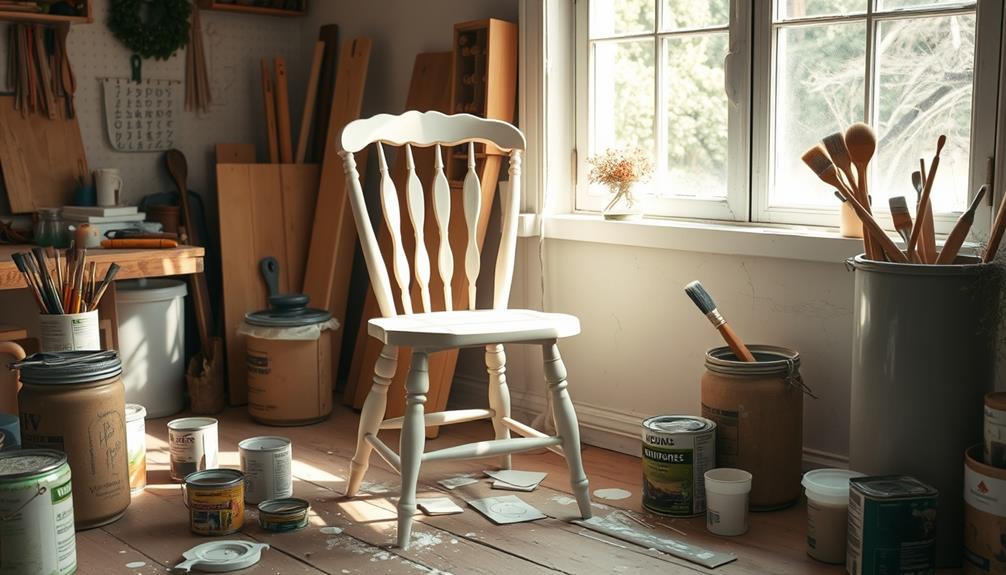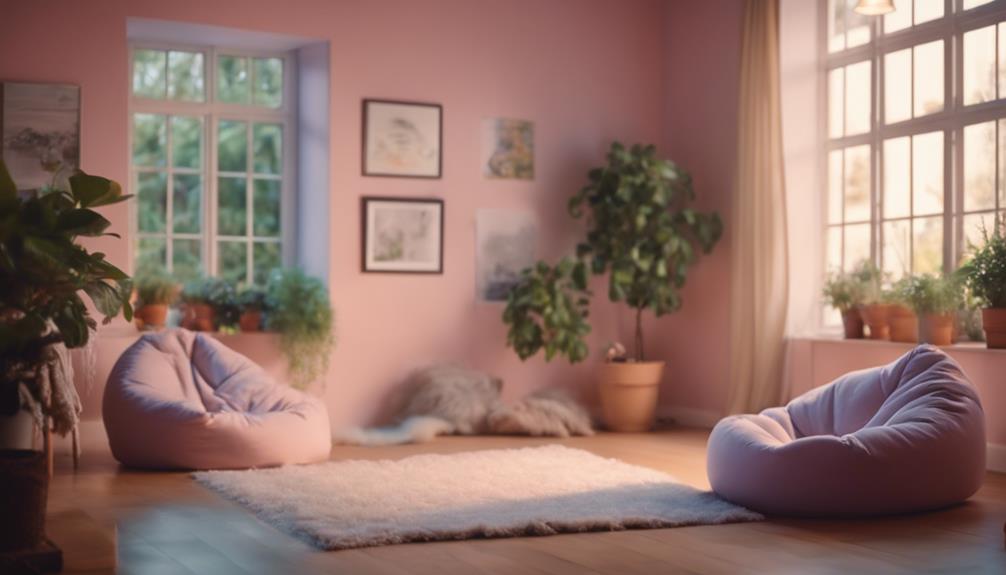When painting furniture, it is important to first clean it thoroughly to remove any dirt. Then, sand the surface to ensure that the paint adheres well. Use high-quality paint specifically designed for furniture and apply 2-3 thin coats, lightly sanding between each one for a smooth finish. Applying a primer before painting will help with adhesion, and sealing your work with a protective topcoat like polyurethane is recommended. Make sure to work in a well-ventilated area and use a drop cloth to protect your surroundings. Avoid common mistakes such as skipping the primer or rushing the drying process. Stay tuned for more tips on achieving a flawless furniture makeover! If you’re looking to refresh your home beyond just furniture, consider fresh front door styling ideas to enhance your exterior. Painting your front door a bold color, adding seasonal wreaths or planters, or updating your house numbers and hardware can quickly boost your home’s curb appeal. Be creative and experiment with different styles to find what works best for your home. These simple changes can have a big impact on the overall look and feel of your space.
Key Takeaways
- Thoroughly clean and sand furniture surfaces to ensure proper paint adhesion and a smooth finish.
- Apply a suitable primer to enhance paint adhesion, choosing the right type based on your project needs.
- Use high-quality, water-based furniture paint, applying 2-3 thin coats for durability while lightly sanding between layers.
- Seal the painted surface with a clear topcoat after sufficient drying time for added protection and longevity.
- Avoid common mistakes like skipping primer, overloading brushes, and rushing the drying process to achieve the best results.
Overview of the Process
When you decide to paint furniture, it's important to start with a solid overview of the process. First, you'll need to prep your piece thoroughly. This includes cleaning the furniture to remove any dirt and grime, followed by sanding the surface to create a better bond for the paint. Sanding helps achieve a smooth finish, so don't skip this step.
Additionally, if you're using appliances nearby while painting, be mindful of their energy consumption, as some may draw standby power even when not in use (energy-efficient appliances).
Once your piece is prepped, it's time to apply your paint. Opt for high-quality, furniture-specific paint and apply 2-3 thin coats for the best coverage and durability. Remember to sand lightly between each coat; this step enhances the overall finish and guarantees a professional look.
After the paint has dried completely, it's essential to seal the surface with a protective top coat. You can choose from options like polyurethane or water-based finishes, which will help safeguard your newly painted furniture from wear and tear.
Essential Supplies Needed
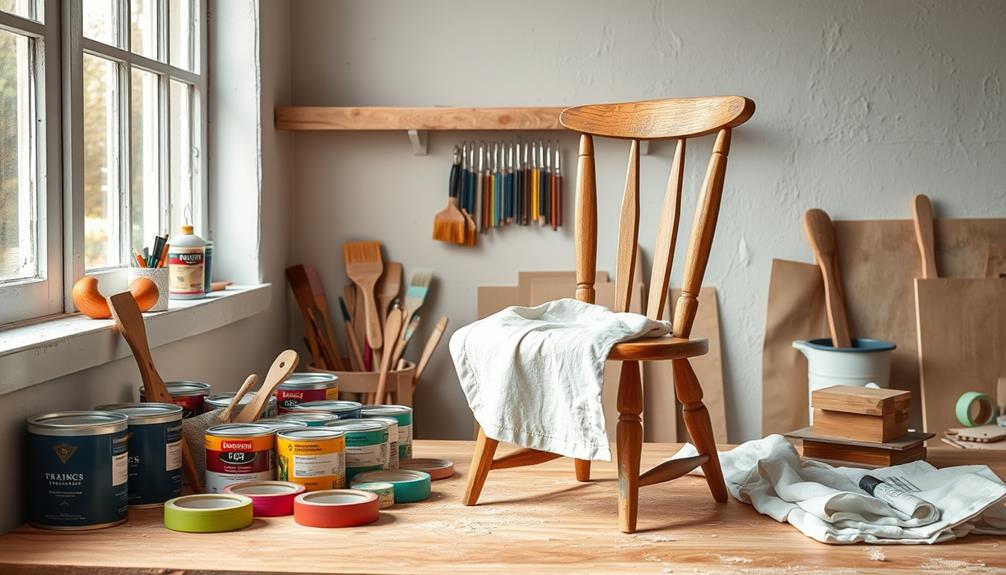
To successfully paint furniture, you'll need a specific set of essential supplies that guarantee a smooth and professional finish. Start with Murphy's Oil Soap for effective cleaning, making sure the surface is free from dirt and grease.
It's also helpful to verify your workspace is free of dust, much like how best vacuums for dust removal can enhance your cleaning routine. Next, grab medium and fine grit sandpaper to prepare the surface, making it smooth and ready for paint adhesion.
You'll also need a quality primer, which enhances the bond between the furniture paint and the surface. For the actual painting, choose a high-quality, water-based furniture paint for durability and easy cleanup.
A good paint brush is essential for applying the paint evenly, but you might also consider foam rollers or optional paint sprayers for larger areas.
Once your paint is dry, don't skip the topcoat! Using a product like Minwax Polycrylic or Finishing Wax protects your beautifully painted surface and extends its longevity.
Preparing Your Workspace
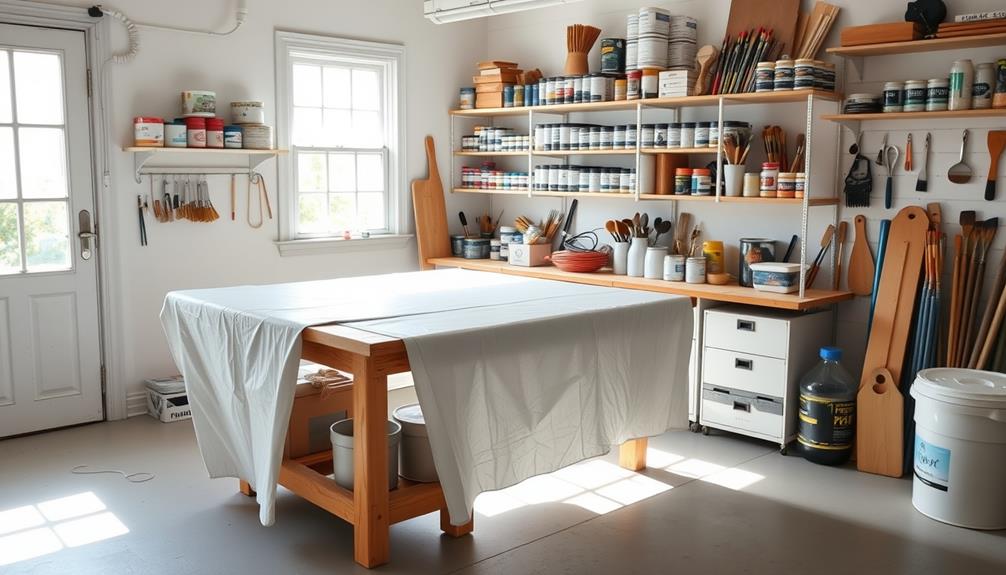
A well-prepared workspace is vital for achieving a flawless furniture painting project. Start by choosing a well-ventilated area to minimize exposure to paint fumes. This not only guarantees your safety but also helps the paint dry evenly.
Additionally, confirming proper airflow around your workspace can enhance the overall efficiency of your project, similar to how air purifier maintenance guarantees peak performance. Next, lay down a drop cloth to protect your floors and surrounding surfaces from spills and drips, making cleanup a breeze.
Before you plunge into painting, remove all hardware and drawers from the furniture using a screwdriver. This gives you easier access to all surfaces and prevents accidental splatters on areas you want to keep paint-free.
Then, use painter's tape to tape off any glass, metal, or mirrored surfaces. This step is vital for protecting these areas and achieving clean lines in your finished project.
Cleaning and Sanding Surfaces
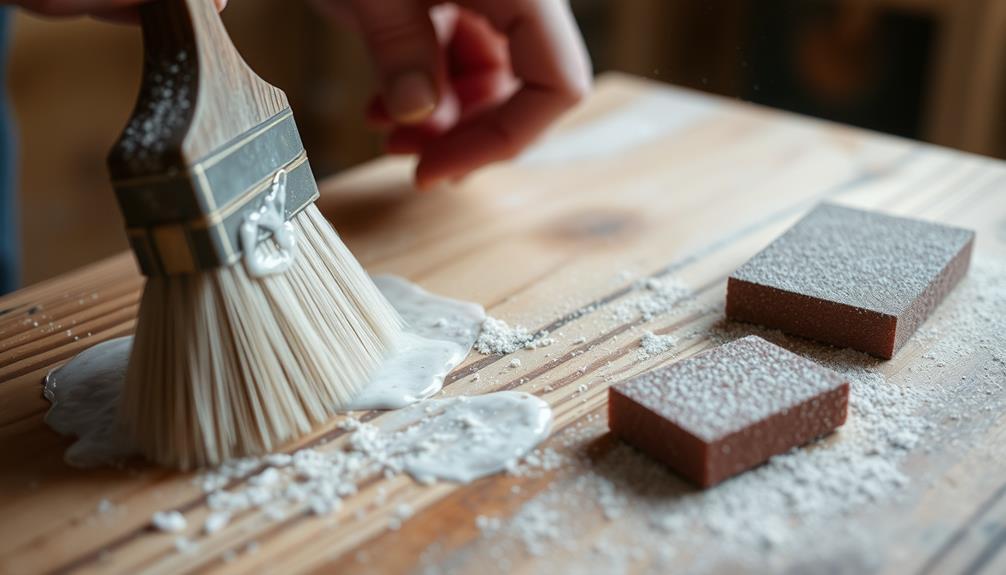
Once your workspace is set up, focus on cleaning and sanding the furniture to guarantee a smooth painting surface.
Begin by thoroughly cleaning the furniture with Murphy's Oil Soap or a TSP cleaner. This step removes dust, grease, and residues that can negatively affect paint adhesion.
After cleaning, grab your sandpaper. Start with a coarser grit, like 80 or 120, to remove any old paint or finishes. Gradually switch to finer grits, such as 220, to smooth the surface before painting.
Make sure to lightly sand the entire surface, creating a texture that enhances paint adhesion. If your furniture has a glossy finish, sanding it will dull the surface, helping the primer and paint stick better.
Don't forget to wipe away any dust with a tack cloth afterward.
Applying Primer Correctly
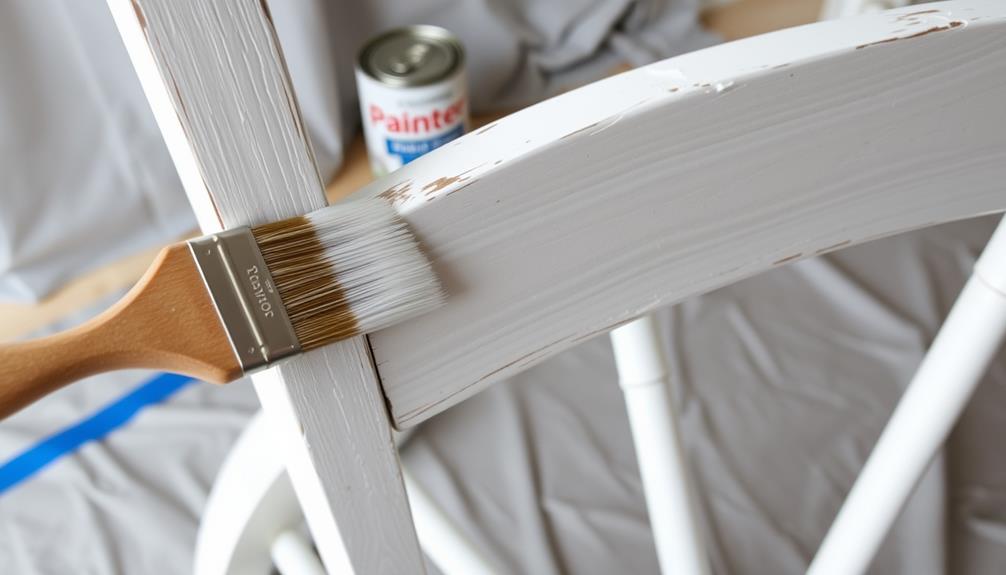
Priming your furniture is essential for achieving a smooth, durable finish.
You'll want to choose the right type of primer and apply it using the best techniques to guarantee ideal coverage.
Let's go over the importance of priming, the different types available, and how to apply them correctly.
Importance of Priming
Getting the primer right is essential for achieving a smooth and durable finish when painting furniture. Priming enhances paint adhesion, especially on raw or previously painted surfaces. By creating a suitable base for your topcoat, it helps guarantee that your paint adheres properly and lasts longer.
If you're working on an item with lingering smells, consider using Zinsser B-I-N, while a water-based primer is great for odor-free projects.
After applying your primer, don't skip sanding! Lightly sanding with 220 grit sandpaper once it's dry can smooth out any imperfections, making your surface ready for painting. Choosing the right primer color is also important; white primer works best for lighter colors, while gray or darker shades can complement rich hues, ultimately affecting the final appearance of your paint job.
Lastly, always allow the primer to dry according to the manufacturer's instructions. This step is essential for ideal results and durability.
Types of Primers
When it comes to choosing the right primer for your furniture project, understanding the different types available can make a considerable difference in your results. Here's a quick overview of some common types of primers you might consider:
| Type of Primer | Best For |
|---|---|
| Water-Based Primer | Odor-free applications |
| Gray Primer | Rich, deep colors |
| White Primer | Lighter shades |
| Zinsser B-I-N | Items with strong smells |
Using a water-based primer is great for odor-free applications, while Zinsser B-I-N works well for items that have strong odors, just guarantee proper ventilation. Gray primer is ideal for enhancing deep color saturation, while white primer helps in achieving lighter shades, considerably affecting the paint's final appearance.
Remember to apply primer using a roller for larger flat surfaces and a brush for detailed areas. After priming, lightly sand the surface with 220 grit sandpaper to smooth out imperfections and enhance paint adhesion. Always inspect the primed surface for any stains or blemishes that might need additional priming before you continue with your paint application.
Application Techniques
After selecting the right primer for your furniture project, applying it correctly is crucial for achieving a smooth finish. Start by using a high-quality brush for detailed areas and a roller for larger flat surfaces. This'll help guarantee even coverage and minimize visible brush strokes.
Follow the manufacturer's drying time—usually around 1-2 hours—before moving on to the next step.
Once the primer is dry, take a sanding block with 220 grit sandpaper and lightly sand the surface. This process smooths out any imperfections and prepares the surface for your coat of paint.
If you're working with raw or previously painted surfaces, consider applying a second coat of primer for maximum adhesion and to cover any remaining flaws.
For projects that require an odor-free environment, go for a water-based primer. If you're dealing with strong odors or stains, Zinsser B-I-N is your best bet.
Mastering these application techniques will set the stage for a flawless finish in your furniture painting project.
Painting Techniques Explained
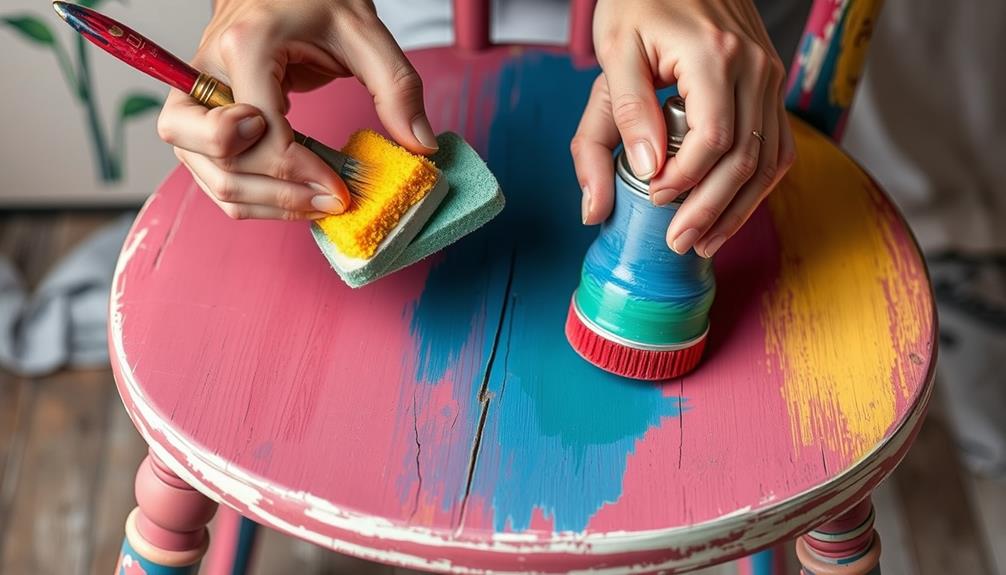
When it comes to painting furniture, choosing the right tools is essential for the best results.
You'll want to use a sponge roller for large areas and a high-quality brush for detailed spots to guarantee an even finish.
Understanding proper application methods can help you achieve a smooth, professional look that lasts.
Brush vs. Roller Techniques
How do you choose between a brush and a roller when painting furniture? The decision often boils down to the details of your project. A brush gives you greater precision and control, making it perfect for intricate designs and tight spaces. On the other hand, a roller excels at covering large flat surfaces quickly, providing a smooth finish with fewer visible brush strokes.
Here's a quick comparison to help you decide:
| Technique | Best For | Finish Quality |
|---|---|---|
| Brush | Detailed areas, edges, corners | Moderate precision |
| Roller | Large flat surfaces | Smooth, even finish |
| Foam Roller | Furniture applications | Ultra-smooth finish |
If you want the best of both worlds, consider combining techniques. Use a brush for edges and corners, followed by a roller for the main surfaces. This method enhances overall coverage and finish, ensuring your furniture looks stunning with minimal effort. Happy painting!
Proper Application Methods
Achieving a flawless finish on your furniture requires mastering proper application methods. Start by choosing a high-quality synthetic brush or foam roller to paint a piece. These tools provide better coverage and minimize brush marks, guaranteeing a professional look.
Before you begin, dilute your paint by about 10% with water. This adjustment enhances flow and helps attain a smoother finish, especially with thicker paints.
As you work, apply thin coats of paint, allowing each layer to dry for 2-4 hours before adding the next. This technique guarantees even coverage and prevents unsightly drips or runs.
To further enhance your results, lightly sand between coats using fine grit sandpaper (220 grit). This step creates a smooth surface and improves adhesion for subsequent layers, resulting in a more polished final product.
Remember to maintain a wet edge while painting to avoid lap marks. If sections dry before blending, you'll notice uneven areas.
Achieving a Smooth Finish
To achieve a smooth finish on your painted furniture, it's vital to use the right techniques and tools. Start by selecting a high-quality paintbrush for detailed areas to avoid shedding and streaking.
For larger surfaces, consider using a sponge roller to help spread the paint evenly. Diluting your paint by about 10% with water can enhance its flow, making application smoother and reducing brush marks.
Maintain a wet edge while painting to avoid lap marks, ensuring each section blends seamlessly. After your first coat, allow adequate drying time, typically 2 to 4 hours, before applying the next layer. This prevents pulling up the previous layer and contributes to a durable finish.
Don't skip sanding between coats! Use fine-grit sandpaper (220 grit) to smooth out imperfections and create a better surface for the next layer.
This step is essential in achieving that professional, smooth finish you desire. By following these techniques and giving each coat the proper drying time, you'll enhance the overall look of your furniture and enjoy a beautifully painted piece for years to come.
Adding Final Protection
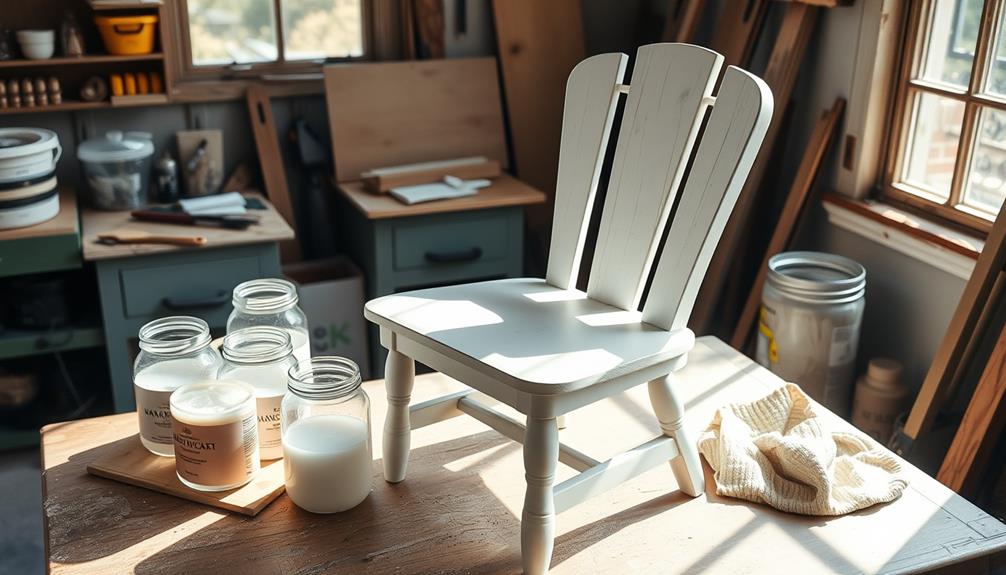
Once your painted furniture has dried for 24 hours, it's time to enhance its durability by adding a clear topcoat. You can choose a water-based option like Minwax Polycrylic or furniture wax to protect the finish effectively.
Water-based topcoats are ideal, as they prevent yellowing, especially on light-colored paints, ensuring a clear and long-lasting seal.
Before applying the topcoat, lightly sand the surface to improve adhesion and achieve a smoother finish. Be sure each layer is fully dry before moving on to the next application. Aim for at least two layers of the topcoat for optimal protection.
After you've applied the final layer, let the sealed furniture cure undisturbed for 1-2 days. This step is essential for the finish to set properly and enhance its longevity.
To keep your furniture looking great, maintain the protective finish by utilizing gently cleaning methods. Avoid harsh chemicals that could damage the surface.
Don't forget to perform touch-ups as needed to prolong the life of your paint job and keep your furniture looking fresh and vibrant.
Common Mistakes to Avoid
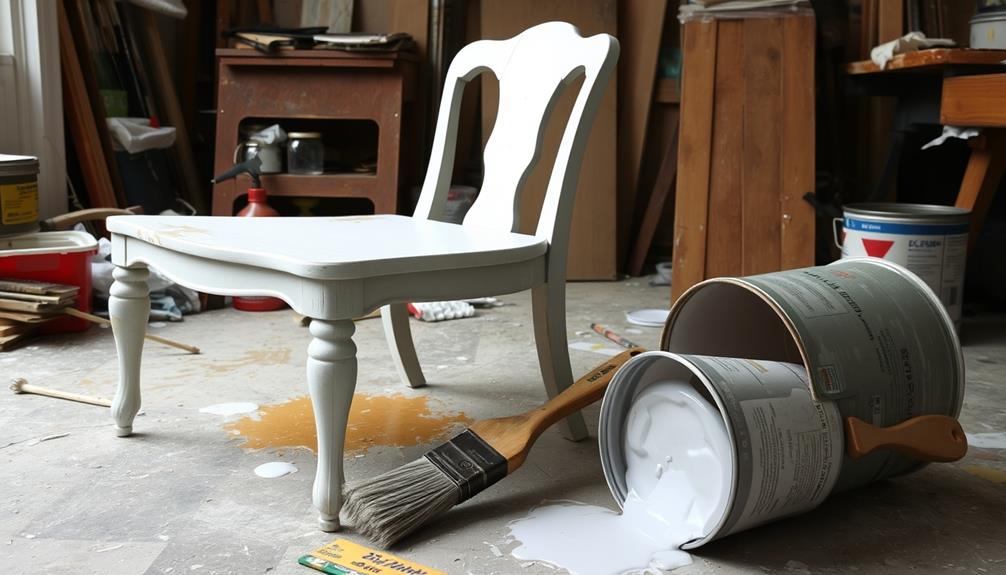
Even after applying a protective topcoat, mistakes can still undermine your furniture painting project. One common error is skipping the primer; without it, you'll likely face poor paint adhesion, leading to chipping and peeling.
When painting furniture, you also need to take care not to overload your brush or roller with paint. Doing so can create drips and uneven surfaces, ruining your final finish.
Another mistake is neglecting to sand between paint coats. This step is vital because it helps achieve a smooth, professional texture. Remember, you need to sand each layer lightly to avoid a rough finish.
Additionally, using low-quality paint can set you up for failure. Opt for good-quality paint to prevent quick chipping or fading that requires constant touch-ups.
Lastly, don't rush the drying process. Allowing each coat to dry fully is important; otherwise, you risk compromising the finish and may need to redo the entire project.
Benefits of Painting Furniture
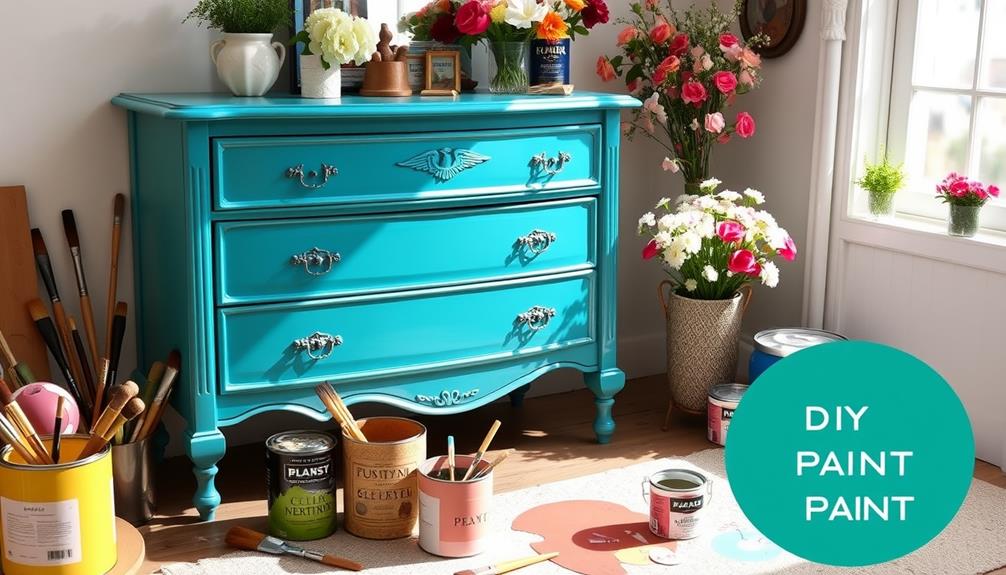
Painting furniture offers numerous benefits that can transform your home and enhance your lifestyle. Here are a few key advantages you'll enjoy:
- Sustainability: Reusing old furniture helps reduce waste and promotes an eco-friendly lifestyle.
- Cost-effective: Revamping worn pieces is often much cheaper than buying new high-quality furniture.
- Customize: You can choose colors and styles that perfectly match your decor, giving your space a unique flair.
By painting your furniture, you not only breathe new life into outdated items but also strengthen your emotional connection with them.
Each piece you transform holds a story, making your home feel more personal and meaningful.
Plus, there's a real sense of personal satisfaction that comes from taking on such a project. You actively participate in shaping your living space, which can be incredibly fulfilling.
Frequently Asked Questions
What Kind of Paint Do You Use on Wood Furniture?
You'd think any paint works for wood, but it doesn't. Instead, choose high-quality furniture paint for durability. Water-based paints are easy, while oil-based ones require caution. Test samples to verify you get the right color.
What Is the Best Way to Paint Furniture for Beginners?
To start painting furniture as a beginner, clean the surface well, sand lightly, apply primer, and use quality paint. Work in thin layers, and don't forget to seal your masterpiece for lasting durability.
Do You Have to Sand Before Painting Furniture?
You can't build a house on sand. Yes, you have to sand before painting. It preps the surface for better adhesion, ensuring your finish won't chip or peel easily. Don't skip this essential step!
Do You Use a Roller or Brush to Paint Furniture?
You can use both a roller and a brush to achieve the best results. Rollers cover large areas quickly, while brushes excel in corners and detailed spots, ensuring a smooth, professional finish overall.
Conclusion
Now that you know how to transform old furniture into stunning statement pieces, don't let fear hold you back. While it may seem intimidating to take on a paint project, the satisfaction of seeing your vision come to life makes it worthwhile. Embrace the mess of creativity as you watch dull surfaces turn vibrant and fresh. With a little preparation and the right techniques, you'll turn your space from drab to fab, one brushstroke at a time!
